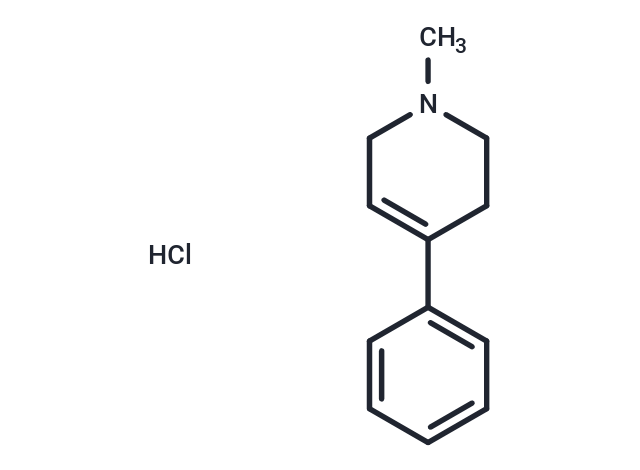Shopping Cart
- Remove All
 Your shopping cart is currently empty
Your shopping cart is currently empty

MPTP hydrochloride is a precursor of MPP+, a dopamine neurotoxin with blood-brain barrier permeability. MPTP hydrochloride is toxic to dopaminergic neurons, which can lead to Parkinson's disease, and is widely used in the construction of animal models of Parkinson's disease.

| Pack Size | Price | Availability | Quantity |
|---|---|---|---|
| 5 mg | $30 | In Stock | |
| 10 mg | $48 | In Stock | |
| 25 mg | $89 | In Stock | |
| 50 mg | $148 | In Stock | |
| 100 mg | $207 | In Stock | |
| 200 mg | $329 | In Stock | |
| 500 mg | $555 | In Stock | |
| 1 g | $798 | In Stock | |
| 1 mL x 10 mM (in DMSO) | $50 | In Stock |
| Description | MPTP hydrochloride is a precursor of MPP+, a dopamine neurotoxin with blood-brain barrier permeability. MPTP hydrochloride is toxic to dopaminergic neurons, which can lead to Parkinson's disease, and is widely used in the construction of animal models of Parkinson's disease. |
| In vitro | METHODS: Human neuroblastoma cells M17 were treated with MPTP hydrochloride (1-50 μM) for 48 h. The expression levels of target proteins were detected by Western Blot. RESULTS: MPTP hydrochloride promoted Tau protein phosphorylation in M17 cells. [1] METHODS: Neuroblastoma cell N2AB-1 and glioma cell C6 were treated with MPTP hydrochloride (0.33-33.7 μM) for 24 h, and the growth curves were examined. RESULTS: MPTP hydrochloride did not affect the cell number of actively growing N2AB-1 or C6 cells. [2] |
| In vivo | METHODS: To construct a subacute Parkinson's model, MPTP hydrochloride (30 mg/kg in 0.9% saline) was administered intraperitoneally to C57BL/6 mice once daily for five days. RESULTS: Subacute MPTP hydrochloride treatment did not cause significant motor deficits, although the dopaminergic system was severely impaired. mPTP hydrochloride significantly increased the level of α-synuclein and the number of astrocytes in the striatum and disrupted the blood-brain barrier in the substantia nigra pars compacta. [3] METHODS: To study the effects of different models on the behavior and pathology of a mouse model of Parkinson's disease, MPTP hydrochloride was used intraperitoneally to construct a subacute model group and a chronic model group. In the subacute model group, MPTP hydrochloride (30 mg/kg) was administered once daily for ten days. In the chronic model group, MPTP hydrochloride (30 mg/kg) was injected once every 3.5 days for five weeks for ten times. RESULTS: In the MPTP hydrochloride-induced subacute Parkinson's disease mouse model, there was a small loss of dopaminergic neurons in the midbrain, but there was no effect on the behavior.The MPTP hydrochloride-induced chronic Parkinson's disease mouse model lost a large number of dopaminergic neurons, which was accompanied by anxiety-like behaviors in addition to motor dysfunction. [4] |
| Alias | MPTP-hydrochloride |
| Molecular Weight | 209.72 |
| Formula | C12H16ClN |
| Cas No. | 23007-85-4 |
| Smiles | Cl.CN1CCC(=CC1)c1ccccc1 |
| Relative Density. | no data available |
| Storage | keep away from moisture | Powder: -20°C for 3 years | In solvent: -80°C for 1 year | Shipping with blue ice. | |||||||||||||||||||||||||
| Solubility Information | H2O: 10 mg/mL (47.68 mM), Sonication is recommended. DMSO: 5 mg/mL (23.84 mM), Sonication is recommended. | |||||||||||||||||||||||||
Solution Preparation Table | ||||||||||||||||||||||||||
DMSO/H2O
| ||||||||||||||||||||||||||

Copyright © 2015-2025 TargetMol Chemicals Inc. All Rights Reserved.